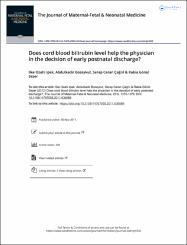Does cord blood bilirubin level help the physician in the decision of early postnatal discharge?
Künye
İpek, İ. Ö., Bozaykut, A., Çaǧrıl, S. C. ve Sezer, R. G.(2012). Does cord blood bilirubin level help the physician in the decision of early postnatal discharge? Journal of Meternal-Fetal and Neonatal Medicine, 25(8), 1375-1378. https://dx.doi.org/10.3109/14767058.2011.636089Özet
Objective: Early postnatal discharge of newborns leads to the risk of readmission to the hospital, mostly for neonatal hyperbilirubinemia. Increasing the length of hospital stay is not an acceptable solution for medical, social and economic constraints. Hence, predicting the high risk neonates for subsequent hyperbilirubinemia is required. This study was planned to investigate the predictive value of umbilical cord blood bilirubin (CBBil) level for significant neonatal hyperbilirubinemia. Methods: Cord blood bilirubin, serum total/direct bilirubin levels and newborn/mother's blood groups were obtained from 350 term neonates. Total/direct serum bilirubin levels were reevaluated in 95 newborns at 72 hours of age when jaundice appeared according to Kramer's dermal zones. Results: Phototherapy treatment was needed in 14.7% of 95 patients. For recognition the newborns at high risk for developing hyperbilirubinemia, using a CBBil cut-off level of 2.60 mg/dl, we found a positive predictive value of 41.18%, negative predictive value of 97.9% and sensitivity of 50%. Conclusion: Newborns with CBBil values below 2.6 mg/dl are at very low risk of developing hyperbilirubinemia and further need of phototherapy. Knowledge of low risk of hyperbilirubinemia in a newborn could encourage the physicians in the decision of early postnatal discharge.
WoS Q Kategorisi
Q3Scopus Q Kategorisi
Q2Kaynak
Journal of Meternal-Fetal and Neonatal MedicineCilt
25Sayı
8Koleksiyonlar
- Makale Koleksiyonu [3770]
- PubMed İndeksli Yayınlar Koleksiyonu [4224]
- Scopus İndeksli Yayınlar Koleksiyonu [6561]
- WoS İndeksli Yayınlar Koleksiyonu [6621]


















